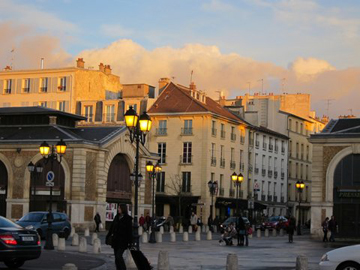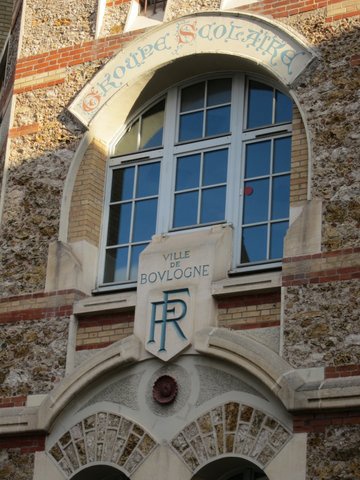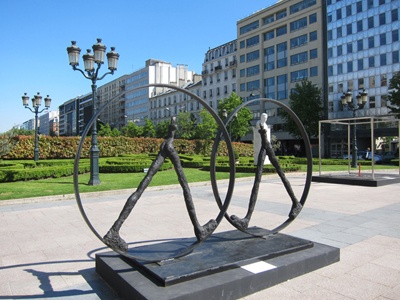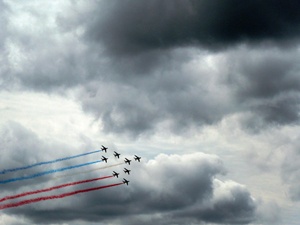Why is it called…
Part 2: French place names or toponyms
Have you ever asked yourself why something is called by a particular name? Place names are also called toponyms. We’ve learned Paris was named for the Celtic tribe the Parisii who lived in the area (why the Parisii were called that is still up for discussion), that the Seine was named for the nymph Séquana. Here are some other topoynms from the Paris area. Feel free to add your town in the comments.
 Versailles: The most likely origin of the name Versailles, first mentioned in 1038 as land belonging to a person named Hughes, comes from the Latin word versare which means to turn over (verser, reverser in French) and probably referred to Hughes’s agricultural efforts of clearing and preparing his land for planting. “Un versailles” or “versail” in old French refers to cleared land.
Versailles: The most likely origin of the name Versailles, first mentioned in 1038 as land belonging to a person named Hughes, comes from the Latin word versare which means to turn over (verser, reverser in French) and probably referred to Hughes’s agricultural efforts of clearing and preparing his land for planting. “Un versailles” or “versail” in old French refers to cleared land.
Stains: The name of the town of Stains, a town north of Paris, rings strangely in anglophone ears because we hear a noun that means « a mark that is difficult to remove ». In fact the name is closer in origin to the English word stagnant referring to the many ponds (stagna in Latin) which were in the area in the 13th century. The name is first mentioned in 1213 in the charter of the Abbey of Saint Denis which made Stains an independant parish.
Noisy-le-Sec: Long ago called Nucetum. Nuce refers to nuts and -tum to dry soils in Latin, hence Noisy le Sec or the place where the walnut trees grow in dry land.
Montreuil: A common toponym of French place names comes from the old French term monstruel, which evolved from the Latin monasteriolum meaning small monastery or church. The town on the edge of Paris was known as Montreuil-sous-Bois for many years. The “sous-Bois” part of the name was officially abandoned only in 1951 which is why you still occasionally see this name used on signs or maps.
 Boulogne-Billancourt: This name is composed of the name of two towns that joined together administratively in 1859 and was re-baptized in 1926. Boulogne was established in 1330 and named for Boulogne-sur-Mer which was in turn named after Bologne in Italy. In the middle ages Boulogne-sur-Mer was as important a pilgrimage site in northern France as Compostelle was in the south. King Philippe IV le Bel visited Boulogne-sur-Mer and its miraculous statue in 1308 and upon return to Paris decided to erect a church dedicated to the Virgin and thus make the pilgrimage journey shorter. The church resembled the Boulogne-sur-Mer church architecturally and the Seine played the role of the sea. The local people referred to their town as Boulogne-la-Petite. After the Revolution it became Boulogne-sur-Seine. Billancourt was first used in 1150 as the designation of the farm of Mr Buolo thus Bullencort or Bollencort and later Billancourt. Cour (or court) refers to the space surrounding an edifice.
Boulogne-Billancourt: This name is composed of the name of two towns that joined together administratively in 1859 and was re-baptized in 1926. Boulogne was established in 1330 and named for Boulogne-sur-Mer which was in turn named after Bologne in Italy. In the middle ages Boulogne-sur-Mer was as important a pilgrimage site in northern France as Compostelle was in the south. King Philippe IV le Bel visited Boulogne-sur-Mer and its miraculous statue in 1308 and upon return to Paris decided to erect a church dedicated to the Virgin and thus make the pilgrimage journey shorter. The church resembled the Boulogne-sur-Mer church architecturally and the Seine played the role of the sea. The local people referred to their town as Boulogne-la-Petite. After the Revolution it became Boulogne-sur-Seine. Billancourt was first used in 1150 as the designation of the farm of Mr Buolo thus Bullencort or Bollencort and later Billancourt. Cour (or court) refers to the space surrounding an edifice.
Les Lilas: A town named The Lilacs? Poetic! And indeed the town, which was established in 1867 under the Second Empire, is named for the woods of birch and lilacs that covered the hillside before the town was established. Other ideas for names for the new town were Napoléon-le-Bois or Commune-de-Padoue, referring to a Duke of Padua who had lived in the area.
 Neuilly: sur-Seine or sur-Marne or Plaisance – there are many many towns named Neuilly in France. Neuilly-sur-Seine traces its name back to two Celtic words lun meaning forest and noue meaning wet plain. The first mentions of the name were in the 13th century as Portus Lulliaco, then came Lugniacum, Luingni, Nully and Nulliacum. At the time Neuilly was one of the places where you could ford the Seine. The years continued to change the name to Port Nully, Port Neuilly. Neuilly was the name given after the Revolution and in 1896 the name officially became Neuilly-sur-Seine
Neuilly: sur-Seine or sur-Marne or Plaisance – there are many many towns named Neuilly in France. Neuilly-sur-Seine traces its name back to two Celtic words lun meaning forest and noue meaning wet plain. The first mentions of the name were in the 13th century as Portus Lulliaco, then came Lugniacum, Luingni, Nully and Nulliacum. At the time Neuilly was one of the places where you could ford the Seine. The years continued to change the name to Port Nully, Port Neuilly. Neuilly was the name given after the Revolution and in 1896 the name officially became Neuilly-sur-Seine
Montrouge: The name Montrouge is first seen in 1194 in the Latin form Rubeo Monte. There are two theories as to the origin. Some say that the landowner in the 11th century was referred to as Guy dit le Rouge due to his red hair. Other says that Montrouge was a high point between two the valleys of the Seine and the Bièvre rivers and that the clay soil had a red color.
 Le Bourget: Home of the biannual air show the town’s name is a one of the French place names that is simply a noun bourg : the « et » at the end is a diminutive and so the name simply means “small town”.
Le Bourget: Home of the biannual air show the town’s name is a one of the French place names that is simply a noun bourg : the « et » at the end is a diminutive and so the name simply means “small town”.
Saint Germain-en-Laye: In 996 Robert the Pious built a monastery dedicated to Saint Germain at this spot. There was another monastery of Saint Germain closer to Paris. The suffixes “en-Laye” and “des-Prés” were added to distinguish them from one another. Laye refers to the forest in old French as opposed to pré is the fields. Briefly under the Révolution Saint Germain was named Montagne-bon-air.
Le Plessis-Robinson: A town named after Robinson Crusoe? Yes it is true. The first mention of the Plessiacus justa Castenetum or plessis near Chatenay is in 839 when the territory of the Abbey of Saint Germain des Prés was split. A plessis was a term for a particular way of trimming hedges that allowed the branches to be woven into fences. Later this area took the name of the landowers and became Plessis-Raoul and then Plessis-Picquet. During the Revolution the town took on the name Plessis-Liberté. The Robinson part is from the 19th century. “Au Grand Robinson” was the name of the first riverside café or guinguette built in 1848 and which had treehouses inspired by the novel The Swiss Family Robinson by Johann David Wyss which in turn was inspired by the novel du Robinson Crusoe by Daniel Defoe. Robinson was eventually used as a general name for the area and became official in 1909.
PS: The word banlieue dates from the Middle Ages and comes from ban and leuca: the Germanic word bann refers to authority, jurisdiction and decrees and the Latin word leuca covers the distance of a league – approximately 4 kilometers. The banlieue was the space beyond the fortified wall of a duchy which was subject that duchy’s legal jurisdiction or bans.
This article is part of a series:

